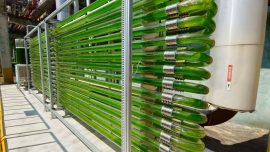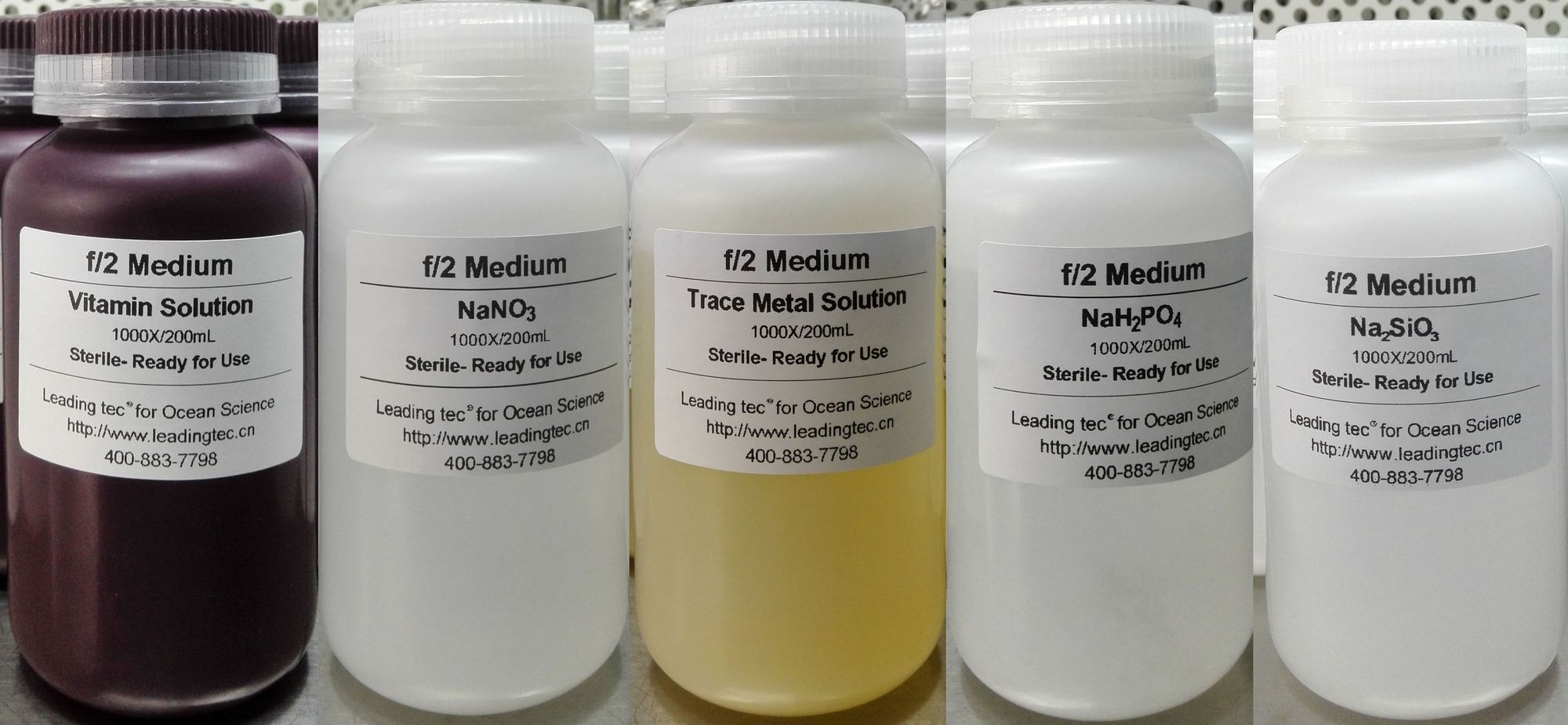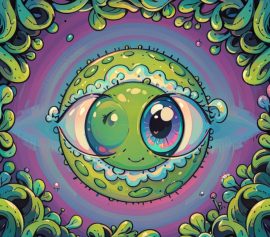Keller and Guillard 1985, Keller et al. 1987
This enriched seawater medium was designed specifically for oligotrophic (oceanic) marine phytoplankters that are poisoned by higher levels of trace metals. The medium uses a 10 fold higher EDTA chelation than most common marine media, and a substantial number of trace elements are included. The necessity of Tris is questionable, and it may be omitted. If organisms do not require silica, the silicate solution should be omitted because it enhances precipitation.
To prepare, begin with 950 mL of filtered natural seawater, add the following components and then bring the final volume up to 1 liter with filtered natural seawater. Autoclave.
|
Component |
Stock Solution |
Quantity |
Molar Concentration in Final Medium |
| NaNO3 |
75.00 g /L dH2O |
1 mL |
8.82 x 10-4 M |
| NH4Cl |
2.67 g/ L dH2O |
1 mL |
5.00 x 10-5 M |
| Na2 β-glycerophosphate* |
2.16 g/ L dH2O |
1 mL |
1.00 x 10-5 M |
| Na2SiO3 • 9H2O |
15.35 g/ L dH2O |
1 mL |
5.04 x 10-4 M |
| H2SeO3 |
1.29 mg/ L dH2O |
1 mL |
1.00 x 10-8 M |
| Tris-base (pH 7.2) |
121.10 g/ L dH2O |
1 mL |
1.00 x 10-3 M |
| trace metal solution | (see recipe below) |
1 mL |
— |
| vitamin solution | (see recipe below) |
0.5 mL |
— |
Trace Metal Solution
To prepare, dissolve the following components to 950 mL of dH2O (heat if necessary) and adjust the pH up with sodium hydroxide until all the components are in solution, approximately 20 pellets per liter of trace metal solution. Bring the final volume to 1 liter using dH2O.
|
Component |
Stock Solution |
Quantity |
Molar Concentration in Final Medium |
| Na2EDTA • 2H2O |
— |
41.60g |
1.11 x 10-4 M |
| FeCl3 • 6 H2O |
— |
3.150 g |
1.17 x 10-5 M |
| MnCl2 • 4H2O |
— |
0.178 g |
9.00 x 10-7 M |
| ZnSO4 • 7H2O |
23.00 g/ L dH2O |
1 mL |
8.00x 10-8 M |
| CoCl2 • 6 H2O |
10.00 g/ LdH2O |
1 mL |
5.00 x 10-8 M |
| Na2MoO4 • 2H2O |
6.3 g/L dH2O |
1 mL |
2.60 x 10-8 M |
| CuSO4 • 5H2O |
2.50 g/ L dH2O |
1 mL |
1.00 x 10-8 M |
f/2 Vitamin Solution
(Guillard and Ryther 1962, Guillard 1975)
First, prepare primary stock solutions. To prepare final vitamin solution, begin with 950 mL of dH2O, dissolve the thiamine, add the amounts of the primary stocks as indicated in the quantity column below, and bring final volume to 1 liter with dH2O.At the NCMA we autoclave to sterilize. Store in refrigerator or freezer.
|
Component |
PrimaryStock Solution |
Quantity |
Molar Concentration in Final Medium |
| thiamine · HCl (vit. B1) |
— |
200 mg |
2.96 x 10-7 M |
| biotin (vit. H) |
0.1 g/ L dH2O |
10 mL |
2.05 x 10-9 M |
| cyanocobalamin (vit. B12) |
1.0 g/ L dH2O |
1 mL |
3.69 x 10-10 M |
Guillard, R.R.L. 1975. Culture of phytoplankton for feeding marine invertebrates. pp 26-60. In Smith W.L. and Chanley M.H (Eds.) Culture of Marine Invertebrate Animals. Plenum Press, New York, USA.
Guillard, R.R.L. and Ryther, J.H. 1962. Studies of marine planktonic diatoms. I. Cyclotella nana Hustedt and Detonula confervacea Cleve. Can. J. Microbiol. 8: 229-239.
Keller, M.D. and Guillard, R.R.L. 1985. Factors significant to marine diatom culture. pp. 113-6. In Anderson, D.M., White, A.W. and Baden, D.G. (eds.) Toxic Dinoflagellates. Elsevier, New York.
Keller, M.D., Selvin, R.C., Claus, W. and Guillard, R.R.L. 1987. Media for the culture of oceanic ultraphytoplankton. J. Phycol. 23: 633-638.
*please note that Na2 b-glycerophosphate is sold as the disodium X hydrate (each batch having a different hydrate level) or as 5 hydrate. The 1987 paper used an x hydrate chemical even though the concentration of the stock was based on an anhydrous weight. Bob Guillard confirmed this for me 10Mar2011. We here at the CCMP have used an x hydrate chemical preparing a 2.16 gram per liter phosphate stock.



